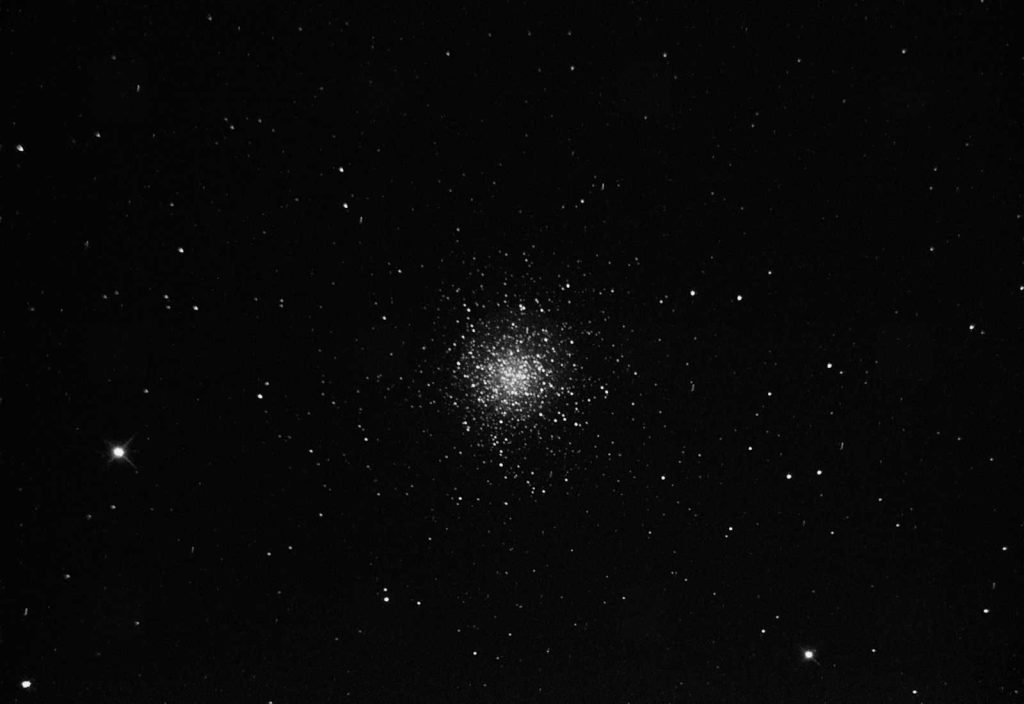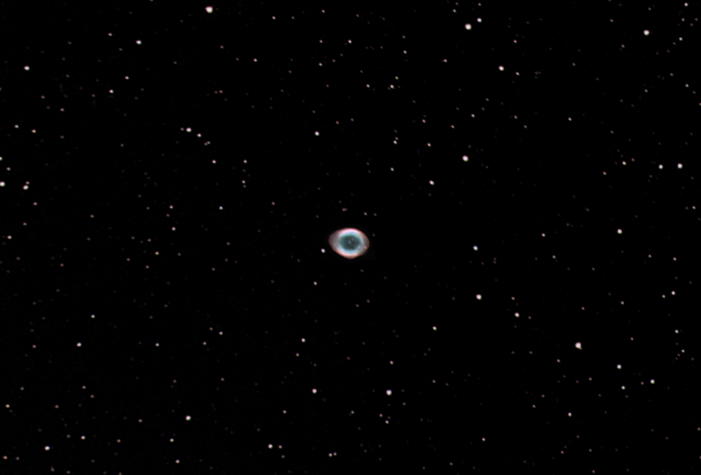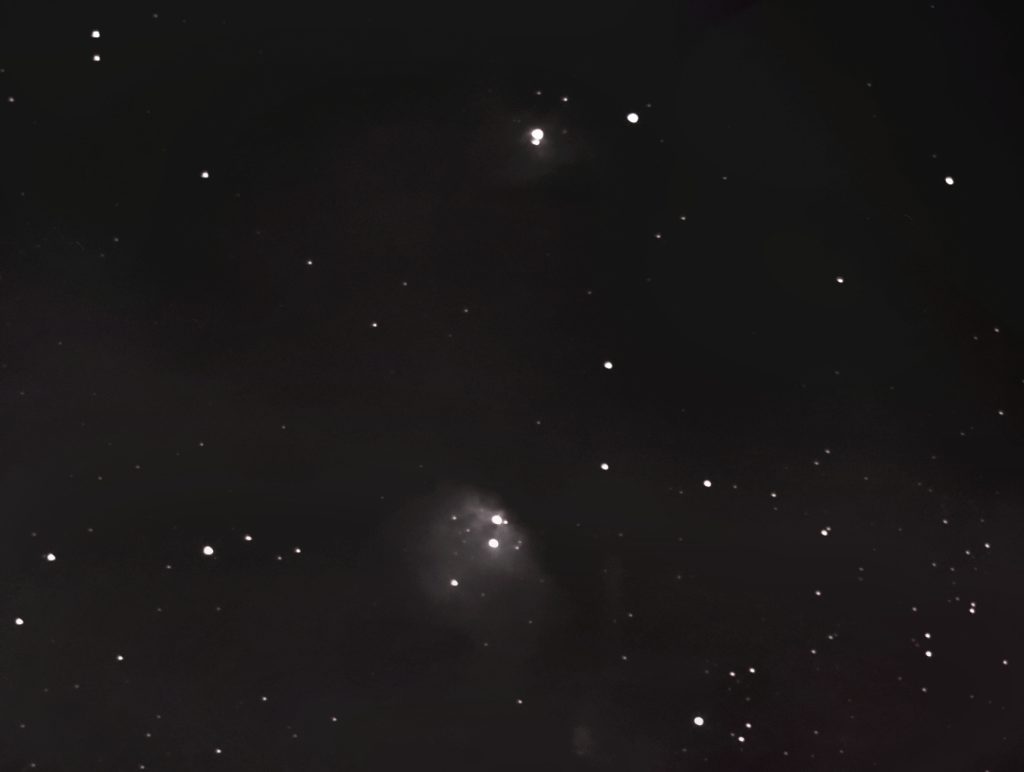Messier Catalog
M1 (2022-11-26)
M1
Crab Nebula in Taurus
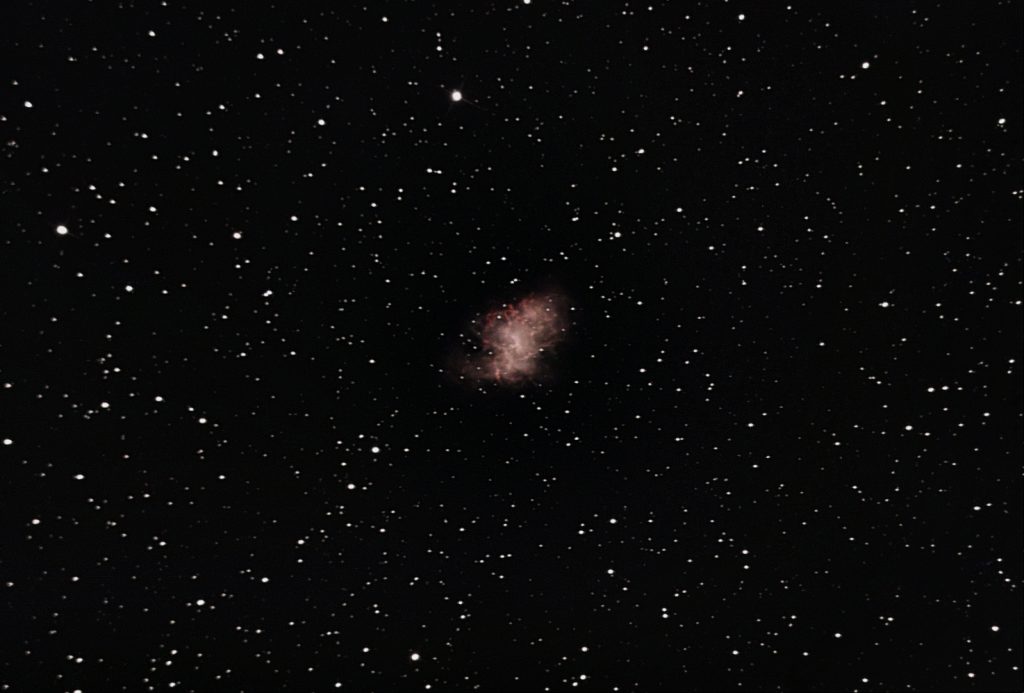
10.1″ f/4.5, Mallincam DS432cTEC
Exposure = 15-19 sec, Live Stacked frames = 30-20 (50 total), Gain = 14 of 250
The Crab Nebula is about 11 light years across and approximately 6500 light years away. In this view it appears about 5 arc minutes across. Lots of subtle rose-coloured cords and twisted knots suffused with a brighter fuzzy cloud. M1 is a supernova remnant that corresponds with a bright supernova recorded by Chinese astronomers in 1054.
North at 12 o’clock, East at 9 o’clock
M3 (2024-05-31)
M3
Globular cluster in Canes Venatici

10.1″ f/4.5, Mallincam DS432cTEC
Exposure = 5 sec, Live Stacked frames = 25, Gain = 15 of 250, Whitepoint = 220
M3 is a very brilliant and richly populated globular cluster, appearing about 10 arc minutes across with a bright 2-3 arc minute core. Relatively sparse on the outer edges but rapidly getting concentrated towards the center. Distance is listed at approximately 34,000 light years away and 670 light years across, or about 4 times larger than M13. Stars in this view go down to at least magnitude 16 and dimmer; bright stars in the center give the core a slightly oblong-shaped appearance approximately in the north-south direction.
North at 2 o’clock, East at 11 o’clock
M4 (2022-06-18)
M4
Globular cluster in Scorpius
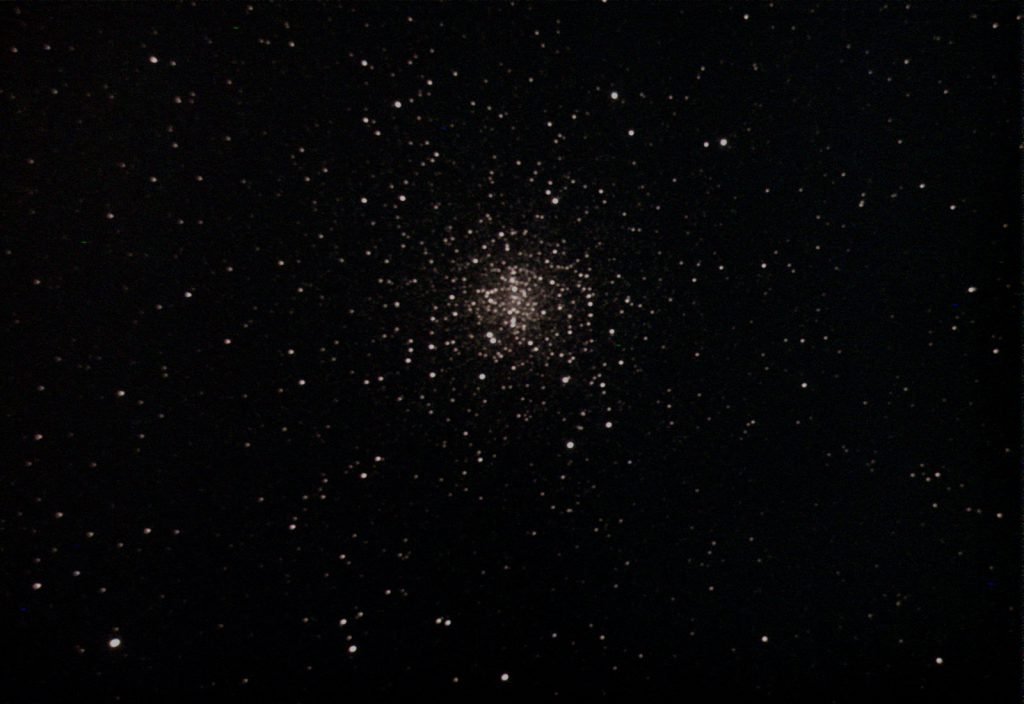
10.1″ f/4.5, Mallincam DS432cTEC with Astronomik UHC filter
Exposure = 3.5 sec, Live Stacked frames = 25, Gain = 63.7 of 250
Compared to other globular clusters, M4 is a very large very loose assembly of stars, appearing about 25 arcminutes across in this view. The stars have a reddish-tinge even with saturation reduced on the Mallincam; according to Burnham’s, M4 is surrounded in a dark nebulosity that effectively reddens their colours. There is a very obvious central bar of stars running vertically through the core. M4 is one of the closest globulars to us, about 7200 light years away, 75 light years across, and listed at 12.2 billion years old.
North at 12 o’clock, East at 9 o’clock
M5 (2024-05-31)
M5
Rose Cluster in Serpens

10.1″ f/4.5, Mallincam DS432cTEC
Exposure = 5 sec, Live Stacked frames = 25, Gain = 15 of 250
The Rose Cluster is a bright relatively sparse globular cluster in the outer regions with a condensed central core, spanning about 20 arc minutes; it’s true physical size is 160 light years across, lying about 25,000 light years away. The bright 5th magnitude star to the lower-left is 5 Serpentis; note that it appears slightly distorted, which I suspect is due to it being a double star, the secondary separated by about 15 arc seconds at Position Angle 45. The outer stars of M5 seem to form curved arcs from right to left that one can imagine represent the profile of the petals on a rose, in this case lying on its side. To me it also looks like the legs of a crab. What pattern do you see?
North at 1 o’clock, East at 10 o’clock
M8 (2022-06-18)
M8
Lagoon Nebula in Sagittarius
10.1″ f/4.5, Mallincam DS432cTEC with Astronomik UHC filter
Exposure = 5-7.5 sec, Live Stacked frames = 20-20 (40 total), Gain = 50 of 250
M8 is a giant H II emission nebula in the Milky Way, about 4000 light years away. Despite lying low in my Bortle 8 skies it still appears quite spectacular. The dark rift separating the bright core of the nebula from the open cluster (NGC 6530) at bottom-left is visible in the eyepiece. Fainter extensions of the nebula reach well toward the left-side of this view and spill over the field of view. The bright star at top-right is 7-Sagittarii, a massive star visible to the naked eye (magnitude 5.37).
North at 11 o’clock, East at 8 o’clock
more images..
M10 (2024-05-31)
M10
Globular cluster in Ophiuchus

10.1″ f/4.5, Mallincam DS432cTEC
Exposure = 5 sec, Live Stacked frames = 21, Gain = 25 of 250
M10 appears to be a slightly lop-sided globular cluster with its brightest stars leaning more in the east direction. The core appears fairly condensed however there is a brighter and looser collection of stars spread across the face of the core; interestingly this is also evident through the eyepiece at medium-high power because that’s how I described it in a sketch on June 24, 2006: “More towards the center can see a ‘C’ of stars shining brightly in the foreground; there seem to be a multitude of other stars across the face of the cluster at this magnification that are on the edge of resolvability, twinkling in and out, perhaps as many as 30 stars.”
M10 appears to be about 20 arc minutes across; it is 14,000 light years away and 84 light years in diameter.
North at 11 o’clock, East at 8 o’clock
M11 (2022-06-18)
M11
Wild Duck Cluster in Scutum
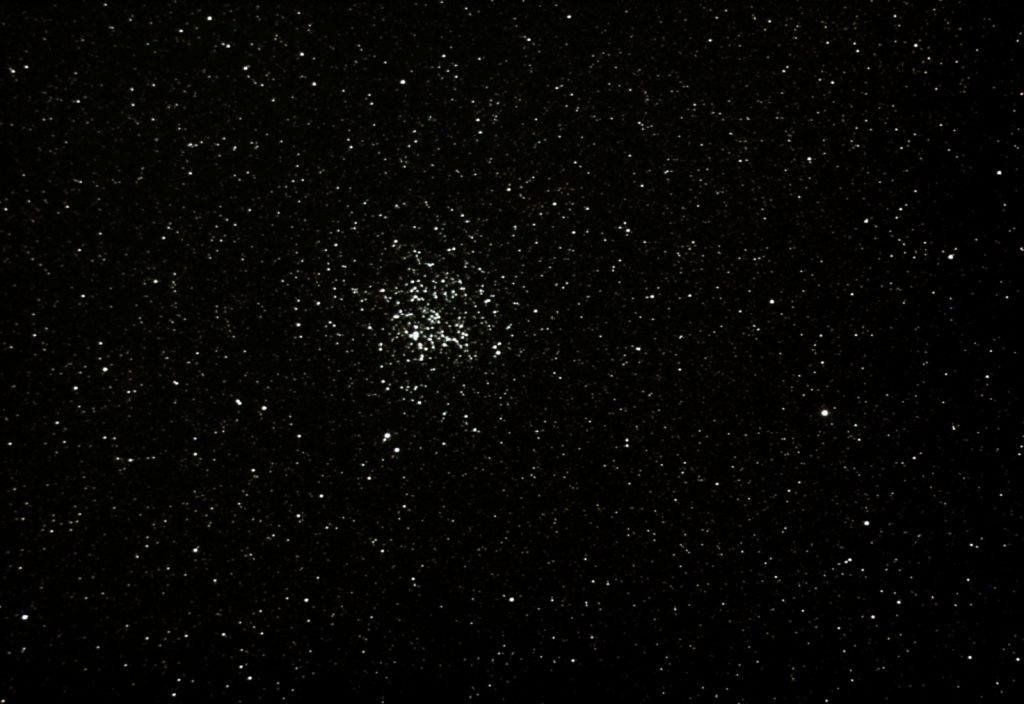
10.1″ f/4.5, Mallincam DS432cTEC with Astronomik UHC filter
Exposure = 5 sec, Live Stacked frames = 20, Gain = 41 of 250
M11 is an unusually rich and dense open cluster containing what appears to be hundreds of stars within about a 15 arcminute space, so dense that it almost looks like a loose globular cluster (see M4 or M12 for example for comparison). The stars have a pale white colour, with one bright star leading the V-shape that points down and to the left (the “duck pack”). M11 is 95 light years across and 6,120 light years away.
North at 11 o’clock, East at 8 o’clock
M12 (2024-05-31)
M12
Gumball Globular Cluster in Ophiuchus
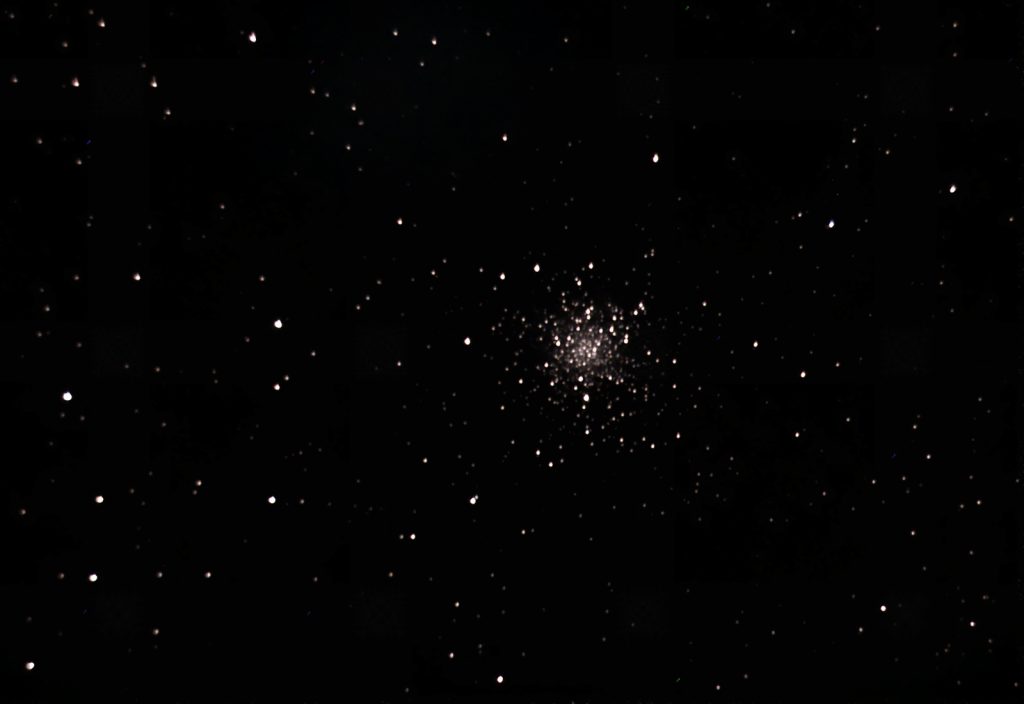
10.1″ f/4.5, Mallincam DS432cTEC
Exposure = 5 sec, Live Stacked frames = 30, Gain = 15 of 250, Whitepoint = 150
M12 is a bright magnitude 7 globular cluster with a fairly distinctive appearance; a very loose collection of stars at two levels of brightness uniformly distributed and mostly resolvable. O’Meara refers to it as the Gumball Globular and I can see why; the different colours and brightness stars are reminiscent of gumballs. The sparseness of M12 is very similar to that of M4; Burnham rated both at IX out of XII on the degree of concentration scale.
The Gumball Globular appears to be about 15 arc minutes across; it is 16,000 light years away and 74 light years in diameter.
North at 11 o’clock, East at 8 o’clock
M13 (2021-05-29)
M13
Great Globular in Hercules
10.1” f/4.5, Mallincam DS432cTEC with 0.5 focal reducer
Exposures = 1.5 sec, Live Stacked frames = 60, Gain = 150 of 250
The combination of brightness and number of stars that resolve across the face of this globular is probably what’s most impressive about M13. Distance listed as approximately 25,000 light years away and 145 light years across.
North at 11 o’clock, East at 8 o’clock
more images..
M16 (2024-06-01)
M16
Eagle Nebula in Serpens

10.1” f/4.5, Mallincam DS432cTEC with Optolong L-eNhance filter
Exposures = 2 sec, Frames = 677, Gain = 30 of 250
M16 is a star-forming region about 70 light years across and 5700 light years distant. The eagle-shaped outline is clearly visible south-east of the star cluster associated with the nebula. The “Pillars of Creation”, made famous by the 1995 photo from the Hubble Space Telescope, is clearly visible as the talons and head of the eagle plus a third larger pillar above the eagle’s head. Many dark cloud structures can be seen cutting through brighter red portions of the nebula..
Image stacked in Autostakkert using the top 75% of 903 TIFF frames, post-processed in PixInsight.
North at 11 o’clock, East at 8 o’clock
more images..
M17 (2022-06-24)
M17
Swan Nebula in Sagittarius
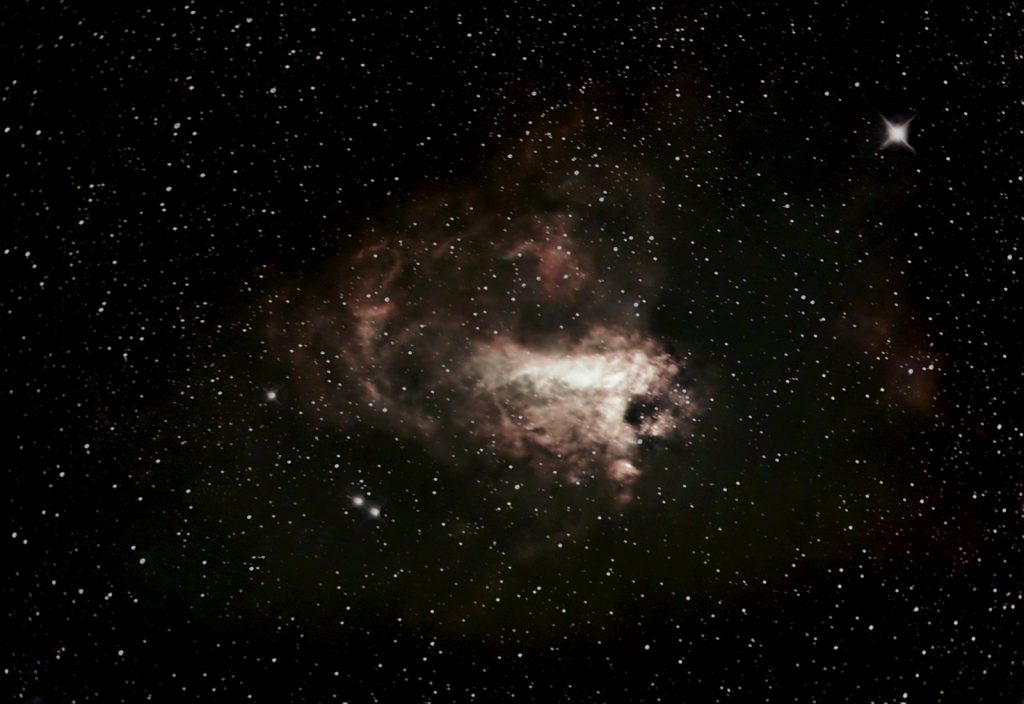
10.1″ f/4.5, Mallincam DS432cTEC with 0.5 focal reducer and Astronomik UHC filter
Exposure = 5-12-20 sec, Live Stacked frames = 20-30-20 (70 total), Gain = 25.54 of 250
Also known as the Swan Nebula, Checkmark Nebula, Lobster Nebula, and the Horseshoe Nebula, M17 is a rich star-forming H II region about 5000 light years away. In the eyepiece and initially when viewed with short exposures in the Mallincam, the checkmark or swan shape is very obvious and bright, about 13 arcminutes in length. In the image above, the nebula extends at least 40 arcminutes across. Two fainter wisps are visible to the right, these are IC 4707 and IC 4706. The bright star to the upper-right is HIP 89851, at magnitude 5.35.
North at 1 o’clock, East at 10 o’clock
M18 (2022-06-24)
M18
Open cluster in Sagittarius
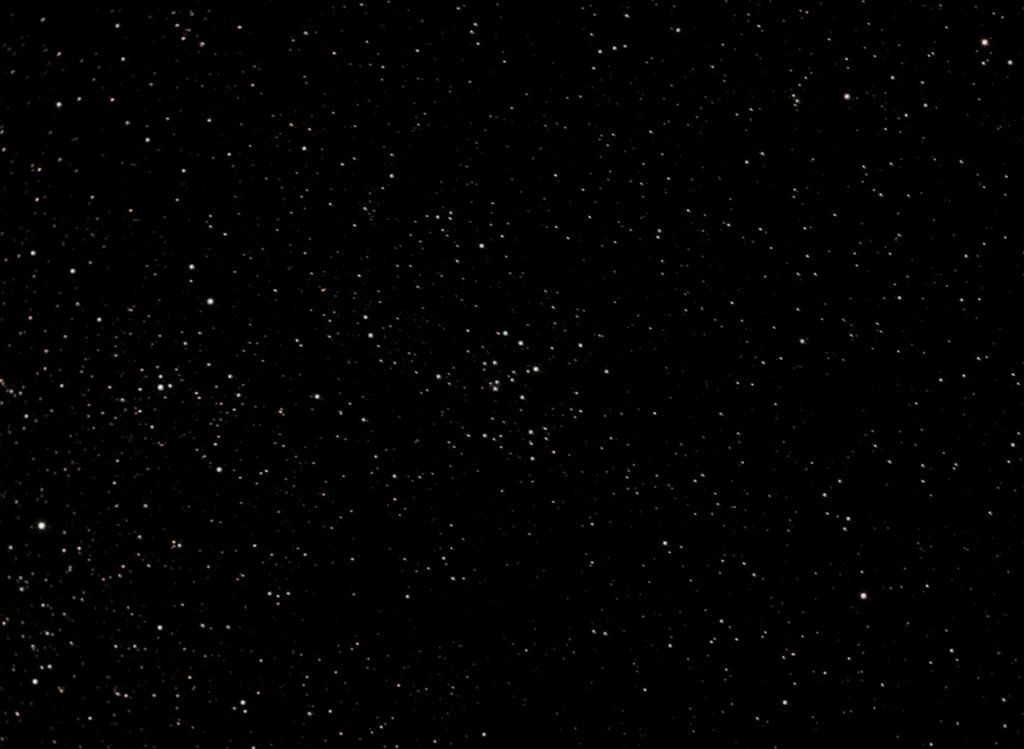
10.1″ f/4.5, Mallincam DS432cTEC with 0.5 focal reducer and Astronomik UHC filter
Exposure = 5 sec, Live Stacked frames = 50, Gain = 40.99 of 250
A very sparse cluster with maybe a couple or so dozen stars, M18 spans 26 light years and is approximately 4200 light years away. Seen here at the center of this image, M18 appears about 6-8 arcminutes across; the brighter 8th to 10th magnitude stars form a rough pentagon shape.
North at 1 o’clock, East at 10 o’clock
M19 (2022-06-18)
M19
Globular cluster in Ophiuchus
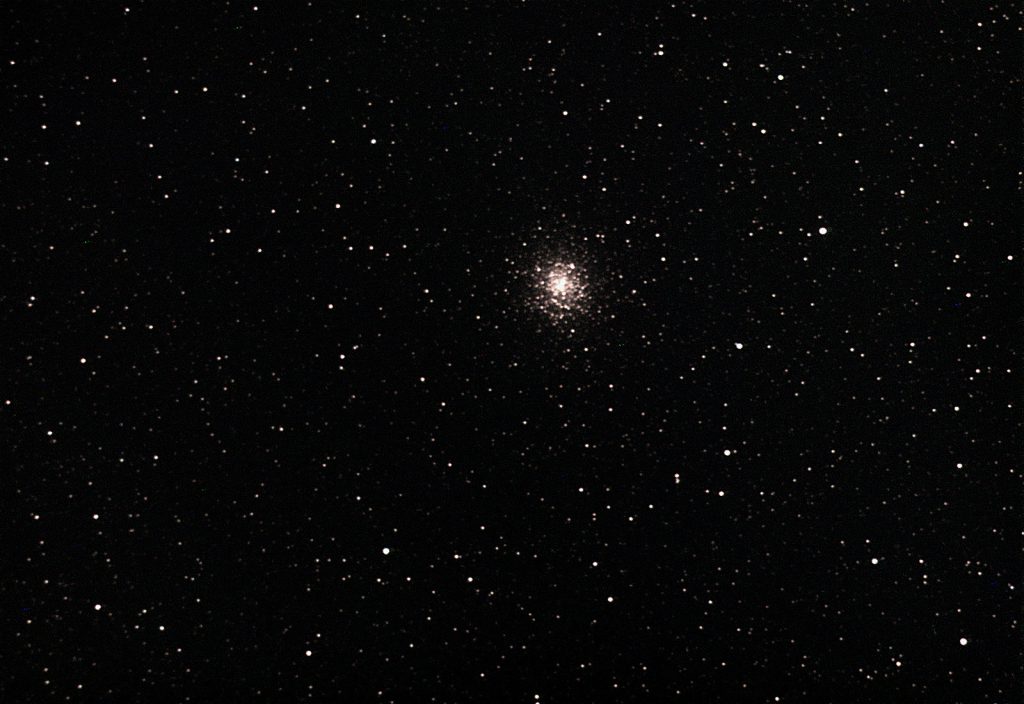
10.1″ f/4.5, Mallincam DS432cTEC with Astronomik UHC filter
Exposure = 5 sec, Live Stacked frames = 15, Gain = 60 of 250
This globular cluster is very compact and oblong in the north-south axis, appearing about 10 arcminutes across in this image. M19 is 28,700 light years away and only 6500 light years from the galactic core.
North at 12 o’clock, East at 9 o’clock
M20
M20
Trifid Nebula in Sagittarius

10.1″ f/4.5, Mallincam DS432cTEC with Astronomik UHC filter
Exposure = 15-20-25 sec, Live Stacked frames = 15-25-20 (60 total), Gain = 21 of 250
M20 is a star-forming H II region similar to the Lagoon Nebula a degree and a half to the south. The Trifid shape shows up beautifully even at short exposures, the dark lanes (Barnard 85) in the main red emission portion of the nebula being obvious. These lanes are fairly easily visible in an eyepiece under good skies. The dimmer northern bluish reflection portion of the nebula only appears after multiple stacked frames.
North at 12 o’clock, East at 9 o’clock
M22 (2022-06-24)
M22
Great Sagittarius Cluster
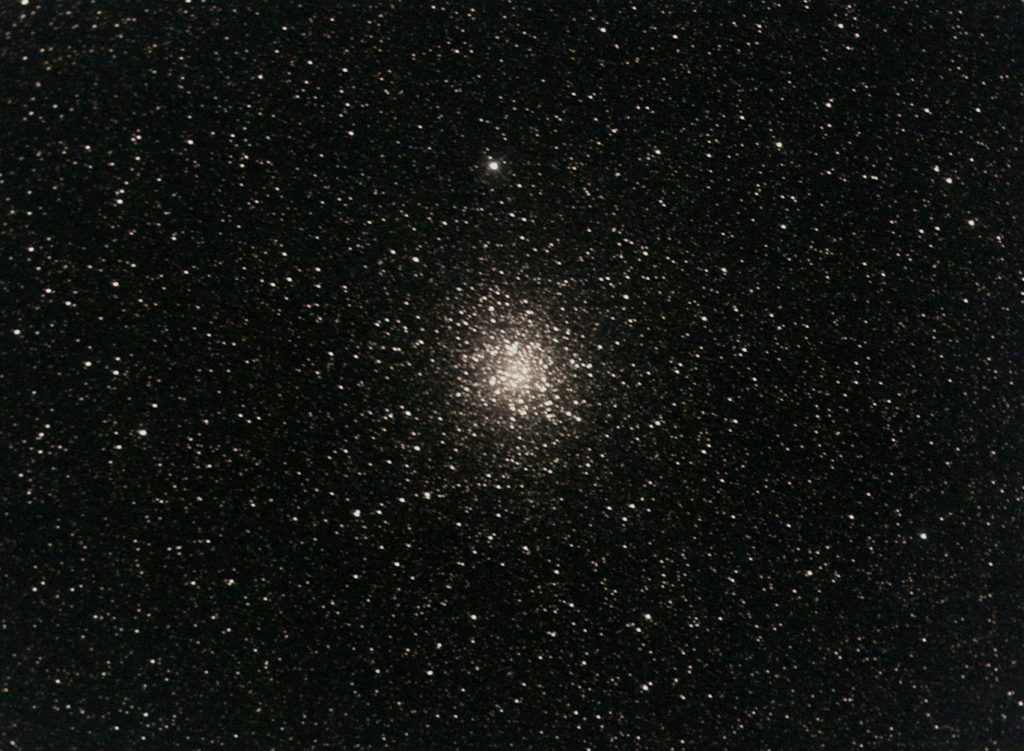
10.1″ f/4.5, Mallincam DS432cTEC with 0.5 focal reducer and Astronomik UHC filter
Exposure = 5 sec, Live Stacked frames = 40, Gain = 41 of 250
Spectacular M22 is one of the brightest globulars in the sky, coming in at a combined magnitude of 5.1. Despite being low in the murk of my light-polluted southern sky, the cluster is easily spotted in 10×30 binoculars. M22 has approximately 70,000 members, is about 100 light years across and is a close 10,000 light years away. In this view, the cluster appears to be about 25 arcminutes across; Burnham’s lists it as a VII out of XII in terms of concentration (XII being least concentrated). In addition to having a large stellar population, M22’s rich starfield probably benefits from being in the vicinity of the Milky Way Galaxy’s core. The bright star just above is 8.6 magnitude.
North at 12 o’clock, East at 9 o’clock
M23 (2022-06-24)
M23
Open cluster in Sagittarius
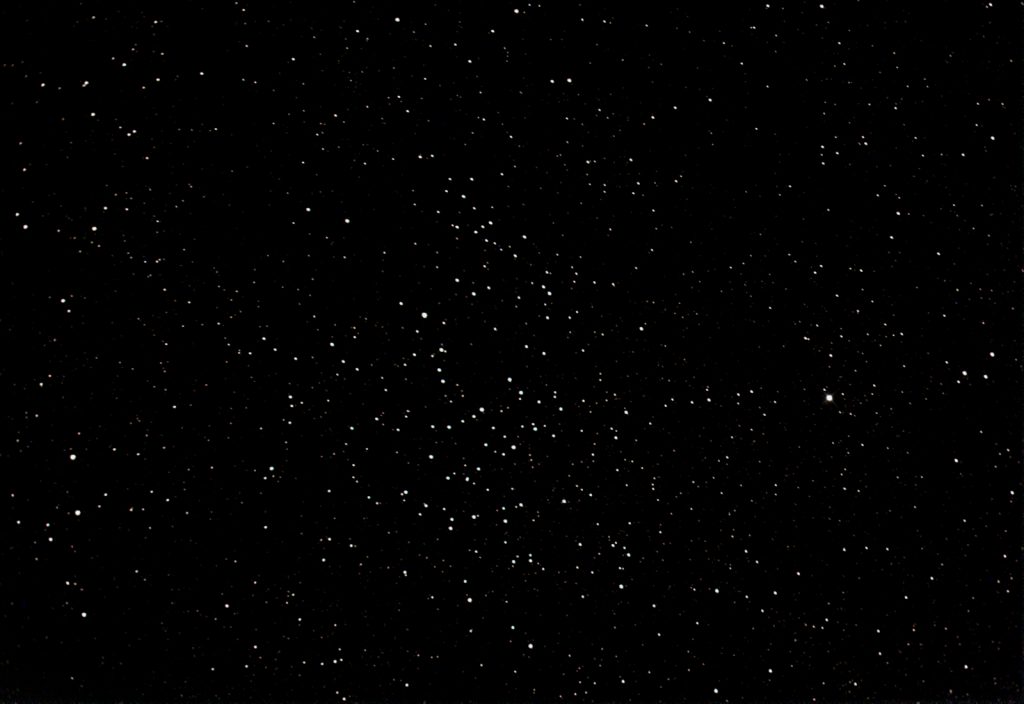
10.1″ f/4.5, Mallincam DS432cTEC with 0.5 focal reducer and Astronomik UHC filter
Exposure = 5 sec, Live Stacked frames = 20, Gain = 41 of 250
A very sparse and large open cluster consisting of a couple hundred evenly distributed suns, M23 appears as a slight concentration in the background of Milky Way stars, at least 30 arcminutes across. The cluster is about 16 light years across and 2000 light years away. Stephen James O’Meara reports that he sees a bat in the pattern of stars at medium power, but I don’t see it; Robert Burnham Jr. sees oriental calligraphy with the curving arcs of stars, which I can see more. Personally, I see a flying Canada goose, with the head at the bright magnitude 6.75 star on the right, with its long neck represented by a string of stars going towards the cluster center, and a wing above and another below the core or body of the goose. What pattern do you see?
North at 1 o’clock, East at 10 o’clock
IC 1284 and M24 (2022-07-02)
IC 1284 and M24
Emission nebula and the Small Sagittarius Star Cloud

10.1″ f/4.5, Mallincam DS432cTEC with 0.5 focal reducer and Astronomik UHC filter
Exposure = 10-18-25 sec, Live Stacked frames = 20-30-50 (100 total), Gain = 35 of 250
IC 1284 is a fairly bright emission nebula with an 8th magnitude star at its center. In the middle of the image here it appears largely rosy-pink with tinges of orange at the core and on the outer edges, about 20 arcminutes across. A couple of smaller, bright, pretty nebula about 5 arcminutes in size are evident below (south-west): NGC 6589 to the right appears to have a dark cleft through the middle; NGC 6590 is brighter and has an interesting dark speck cloud sitting in front of it. All three nebula are about 5500 light years away.
The entire area of this image is situated in a very bright portion of the Milky Way with many diffuse glowing regions and darker obscuring clouds scattered throughout. The brightest areas on the upper and lower right-side of the image are the southern-most reaches of the large nebula M24, the Small Sagittarius Star Cloud. M24 spans at least 2 degrees in the sky; in terms of actual physical size it is quite massive, approximately 15,000 light years in length and located over 10,000 light years away.
North at 1 o’clock, East at 10 o’clock
M25 (2022-06-24)
M25
Open cluster in Sagittarius
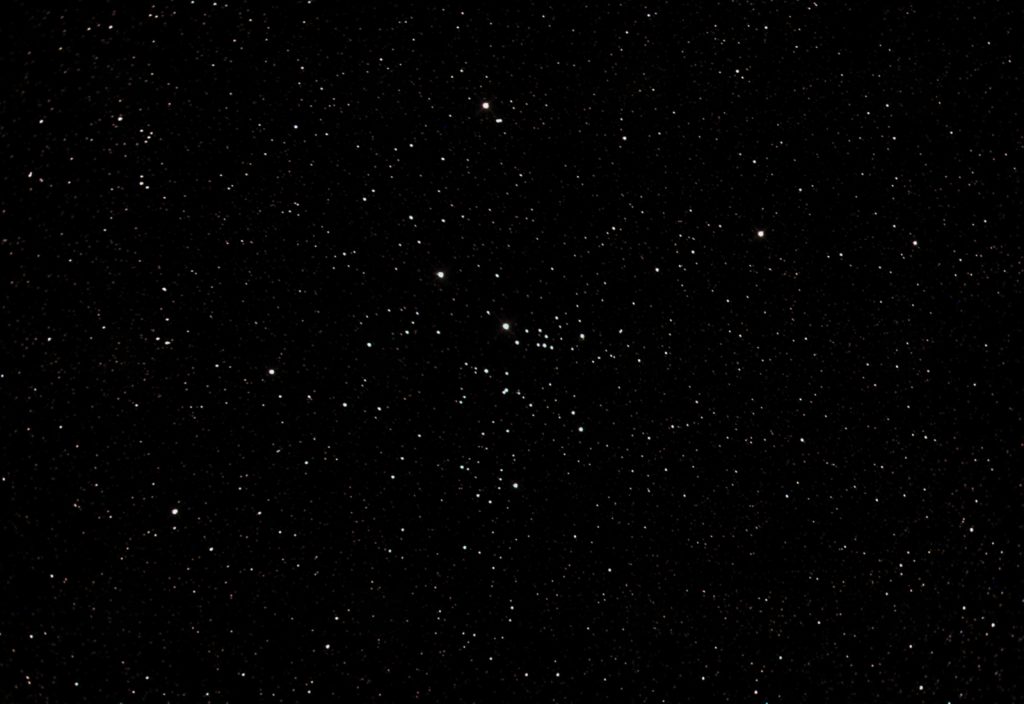
10.1″ f/4.5, Mallincam DS432cTEC with 0.5 focal reducer and Astronomik UHC filter
Exposure = 5 sec, Live Stacked frames = 30, Gain = 41 of 250
Another bright open cluster in Sagittarius, M25 is approximately a 1/2 degree across and is listed as 13 light years across and 2000 light years distant. There are a few dozen bright stars amongst the hundreds of fainter ones in this cluster. A couple of curved arcs of stars exist near the center, forming longer lines pointing to brighter stars at the outer edges. The brightest star near the center is U Sagittarii, a cepheid variable whose magnitude varies between 6.5 and 7.2 over a period of 6.7 days; when this image was taken, it looks like U Sgr was close to the same brightness or a little dimmer than the bright star near the top edge of the frame, HIP 90900 which is magnitude 6.95, so this suggests U Sgr was near minimum, around 7.0 or 7.1.
M25 is the only Messier object that is listed in the the Index Catalogue, as IC 4725.
North at 1 o’clock, East at 10 o’clock
M26 (2022-06-24)
M26
Open cluster in Scutum

10.1″ f/4.5, Mallincam DS432cTEC with 0.5 focal reducer and Astronomik UHC filter
Exposure = 5 sec, Live Stacked frames = 30, Gain = 41 of 250
M26 is a small compact cluster consisting of a couple dozen brighter stars of magnitude 9 to 12, measuring about 12 arcminutes across. The shape at the core is distinctly trapezoidal. Both O’Meara and Burnham Jr. report that there is a 2 to 3 arcminute “hole” at the center, inside the trapezoid, that has a couple of possible explanations: either it’s a dark nebula obscuring stars, or there are in fact less stars there – the question apparently has yet to be resolved.
M26 is 22 light years across and relatively distant for an open cluster at 5160 light years away.
North at 1 o’clock, East at 10 o’clock
M27 (2021-05-28)
M27
Dumbbell Nebula in Vulpecula

10.1″ f/4.5, Mallincam DS432cTEC
Exposure = 15 sec, Live Stacked frames = 15-15-15 (45 total), Whitepoints = 255-220-180, Gain = 10 of 250
M27 is an impressive planetary nebula at almost any level of magnification, roughly 7 arcminutes across. Two distinct lobes in the North-East and South-West directions have distinctly reddish tinges on the edges, with the SW one being brighter overall. The disk appears slightly oblong along the north-south axis. The SE and NW hollower areas have softer edges that bleed-off into the background stars more gradually with filamentary shapes within them. Lots of intricate knotty detail is visible in red and cyan colours within the core of the nebula, details that are not visible through the eyepiece. The magnitude 14 white dwarf central star can be seen here too. M27 is 1360 light years away and about one and a half light years across.
North at 10 o’clock, East at 7 o’clock
M31, M32, and M110
M31, M32, and M110
Andromeda Galaxy and satellite galaxies
80mm f/5, Mallincam DS432cTEC with 0.5 focal reducer and Astronomik UHC filter
Exposure = 20-40-80 sec, Live Stacked frames = 10-10-10 (30 total), Gain = 60 of 250
A wide-angle view of M31 that includes satellite galaxies M32 (appears as a fuzzy pale-yellow bright star below-right of M31 core) and M110 (above M31). Two distinct dark dust lanes can be seen above the core of M31 and some clumpy areas with dark patches show up on the left and right outer edges of the spiral. M31 stretches about 2 degrees across in this view, M110 is about 10 arcminutes, and M32 is about 2 arcminutes. M31 and M32 are about 2.5 million light years away, while M110 lies a little further at 2.7 million light years.
North at 10 o’clock, East at 7 o’clock
more images..
M33
M33
Triangulum Galaxy
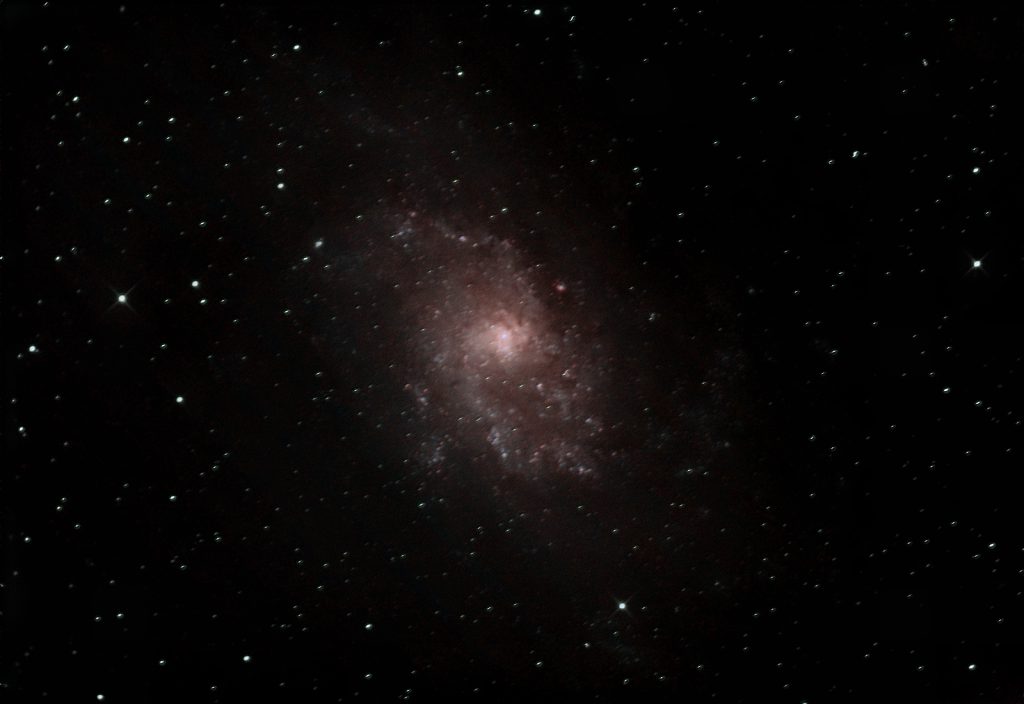
10.1” f/4.5 Mallincam DS432cTEC with 0.5 focal reducer
Exposures = 15-25 sec, Live-stacked frames = 20-25 (45 total), Gain = 15 of 250
The size of M33 here as seen from the city via EAA techniques appears to be about 25′ across, with the brighter portion appearing in the SW or bottom-half of the disk. Various light and dark concentrations, dust clouds, and HII regions throughout the loose spiral arm structure can be seen. One such region is NGC 604, appearing as a slightly blurred bright star at about 10 o’clock from the core. M33 is thought to be a satellite of M31 and is approximately the same distance (slightly further) away.
North is at 11 o’clock, East at 8 o’clock
M36 (2022-11-26)
M36
Open cluster in Auriga
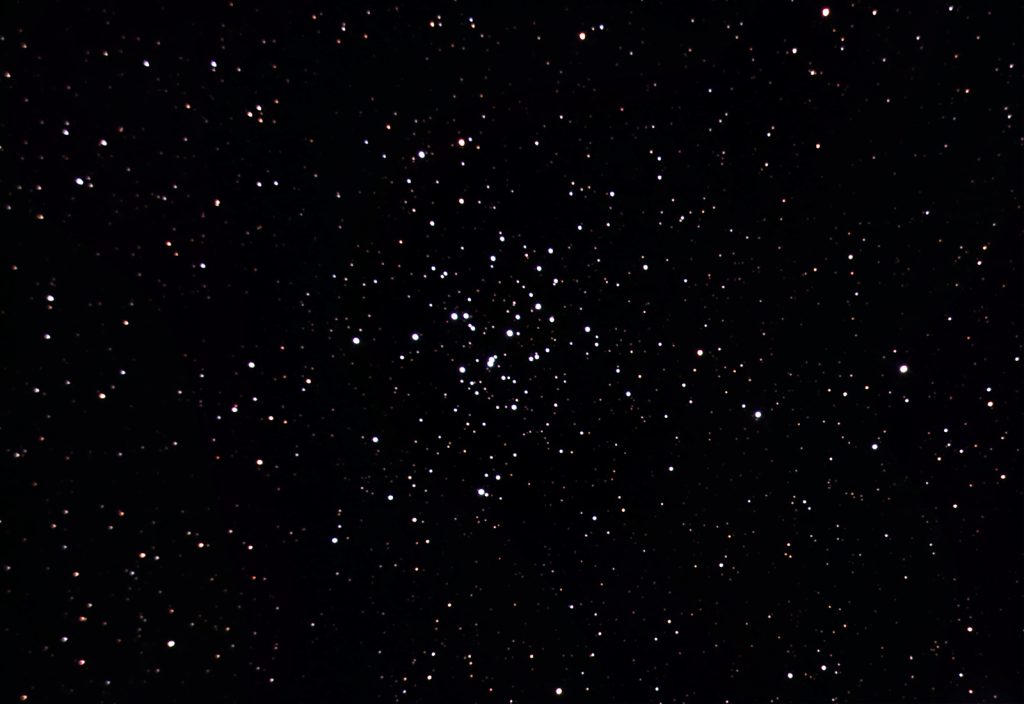
101.” f/4.5, Mallincam DS432cTEC
Exposure = 5 sec, Live Stacked frames = 15, Gain = 25 of 250
M36 is a bright, large star cluster with little compression. Burnham’s says it “contains about 60 stars of magnitude 9 to 14”. The cluster appears to be approximately 10 arc minutes across. At the center is a double star, Struve 737, seen here as a couple of brighter stars of magnitude 9 “touching” one another; in reality they are separated by 11 arc seconds. M36 is relatively young at 25 million years, is about 4340 light years away and 14 light years across.
North at 11 o’clock, East at 8 o’clock
M37 (2023-01-14)
M37
Open cluster in Auriga
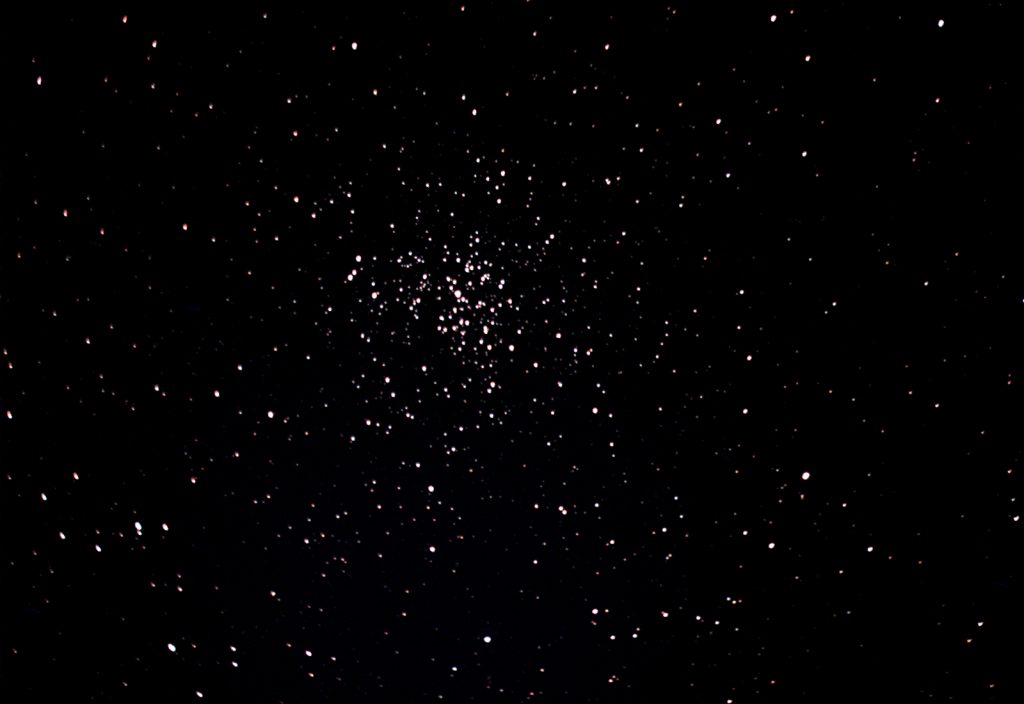
10.1″ f/4.5, Mallincam DS432cTEC with 0.5 focal reducer
Exposure = 5 sec, Live Stacked frames = 20, Gain = 40 of 250
M37 is a beautiful large, compressed star cluster that looks almost like a loose globular cluster (see M4 for comparison). Burnham’s says it “contains about 150 stars down to magnitude 12.5; the total population may be in excess of 500 stars”. Both Burnham’s and O’Meara refer to a ruby or topaz coloured bright 9.5 magnitude star near the cluster center. – can you see it in the image above?
M37 is significantly older than it’s sibling, M36, listed at approximately 350 to 550 million years old. The cluster spans about 15 arc minutes, is about 25 light years across in actuality, and similar to M36 is 4500 light years away.
North at 1 o’clock, East at 10 o’clock
M38 (2023-01-14)
M38
Open cluster in Auriga
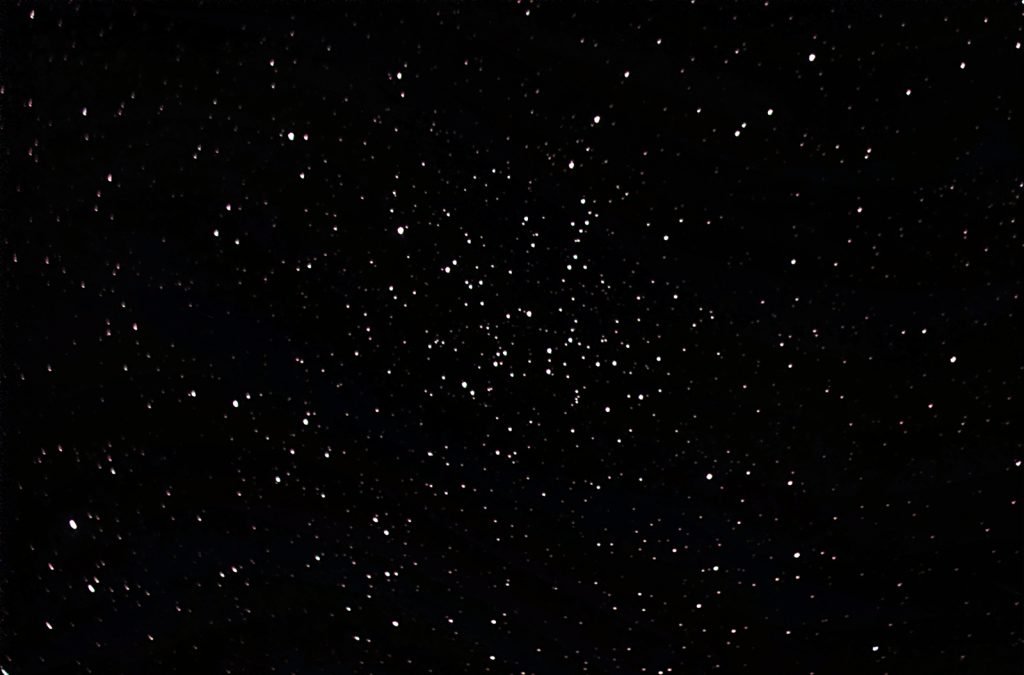
10.1″ f/4.5, Mallincam DS432cTEC with 0.5 focal reducer
Exposure = 5 sec, Live Stacked frames = 20, Gain = 40 of 250
M38 is a large loose open cluster, about 120 stars spanning approximately 20 arc minutes. Burnham’s mentions “It is a scattered group of irregular form, with the brightest stars in a pattern resembling an inverted letter Pi”. Can you see the inverted Pi shape?
M38 is 3500 light years away, and about 26 light years across, similar in size to it’s sister M37 just less dense. Age-wise M38 is estimated to be 290 million years old.
North at 1 o’clock, East at 10 o’clock
M42 (2022-11-26)
M42 and M43
Great Orion Nebula and De Mairan’s Nebula
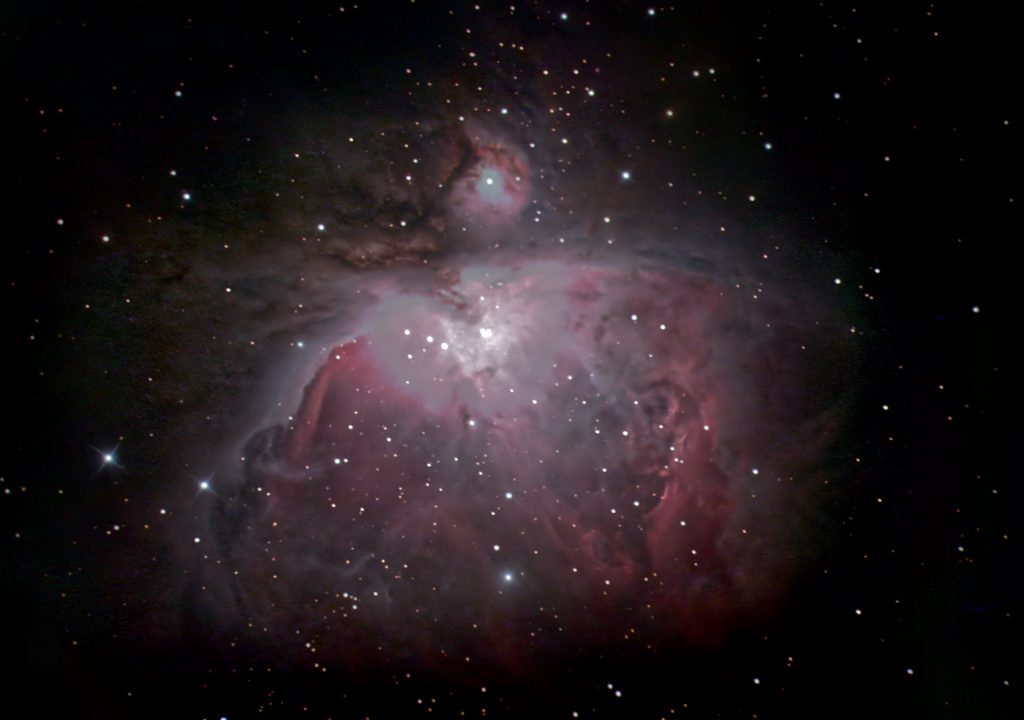
10.1″ f/4.5, Mallincam DS432cTEC with 0.5 focal reducer
Exposures = 2-12-22-22 sec, Live Stacked frames = 15-15-15-45 (90 total), Gain = 2-2-2-6 of 250
The Great Orion Nebula M42 is most of what we see here in this image, with the exception of the upside-down “comma” shaped nebula at the top which is M43 De Mairan’s Nebula. A multitude of pink and red hues dominate the colours, with tinges of grey-blue associated mainly with the “wings” of the nebula and more diffuse regions. According to Wikipedia, the red colouration is associated to Hydrogen-alpha radiation while the blue-violet is reflected radiation from the massive O-class stars at the core of the nebula. Dark brown obscuring material can also be see in between M42 and M43. At the center of M42’s core lies the Trapezium, 4 tightly-packed stars powering the nebula.
M42 spans about 45 arcminutes in this image; in reality it is about 1300 light years away and approximately 24 light years across.
This image was composed in Affinity Photo by layering a shorter live stack (15 frames at 2 sec Gain 2) as a luminosity mask with the full stack indicated above. This reduced the brightness of the central core area to reveal the Trapezium.
North at 1 o’clock, East at 10 o’clock
more images..
M45
M45
Pleiades in Taurus
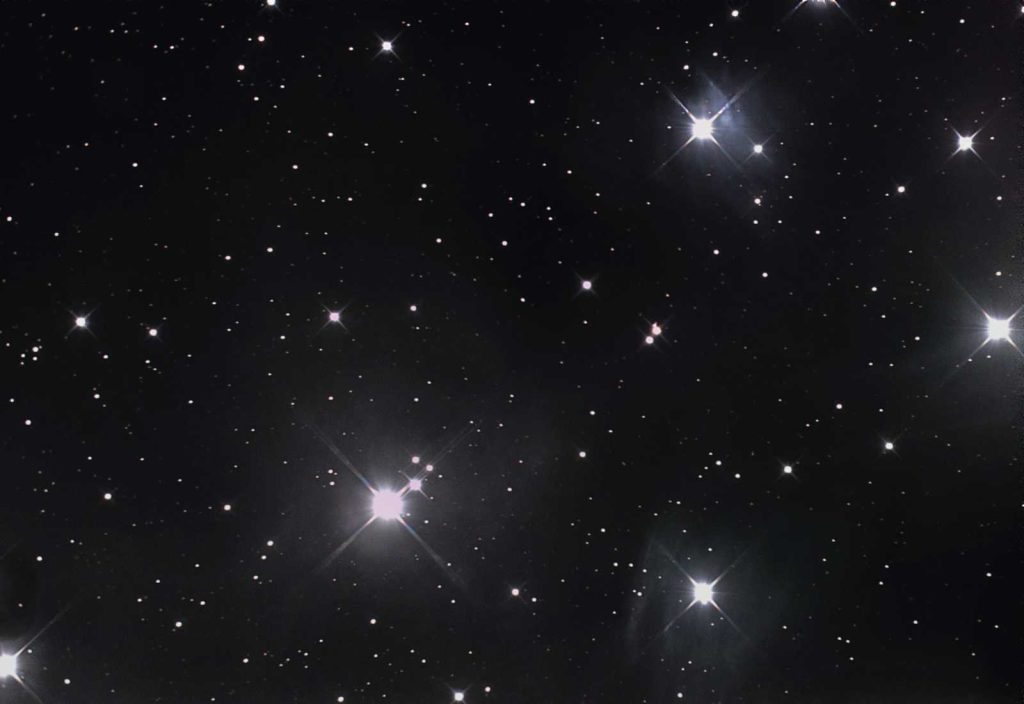
10.1” f/, 4.5Mallincam DS432cTEC with 0.5 focal reducer
Exposure = 15 sec, Live-stacked frames = 10, Gain = 15 of 250
The reflection nebula portion of the Pleiades cluster is easily pulled out of the background sky via EAA, something that is not visible with just an eyepiece. The wispy details around Merope (lower-left “bowl” star) and Maia (upper-right) are especially striking.
North at 12 o’clock, East at 9 o’clock
M51
M51
Whirlpool Galaxy in Canes Venatici
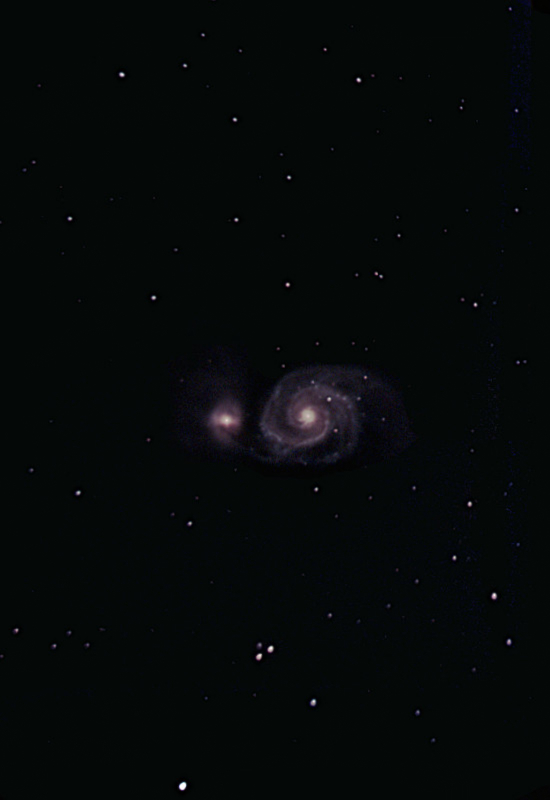
10.1″ f/4.5, Mallincam DS432cTEC with Meade Series 4000 Nebular Filter
Exposure = 15 sec, Live Stacked frames = 100, Gain = 80/250
Stacked frames totalling 25 minutes worth of exposure. Some very faint extended nebulosity can be seen around NGC 5195, the dwarf satellite galaxy at left. Lots of dark lane and bright knot details are visible within the Whirlpool’s spiral arms, only a hint of which can be seen visually through the eyepiece.
North at 10 o’clock, East at 7 o’clock
M52 and NGC 7635(2022-07-08)
M52 and NGC 7635
Salt-and-Pepper Cluster and the Bubble Nebula in Cassiopeia

10.1″ f/4.5, Mallincam DS432cTEC with 0.5 focal reducer and Astronomik UHC filter
Exposure = 10-18-25 sec, Live Stacked frames = 20-20-60 (100 total), Gain = 50 of 250
NGC 7635, or the Bubble Nebula (right), also known as Caldwell 11, is a beautiful H II emission nebula that appears near to the open cluster M52, making a fantastic pairing. In reality, the two share a chance alignment as M52 is 4600 light years away while the Bubble Nebula is twice as far. Bubble is an appropriate name, as the core nebula has a distinct circular shape that looks very much like a soap bubble. The Salt-and-Pepper Cluster is also appropriate as M52 has a fairly even, compressed (for an open cluster) distribution of similarly bright stars. Both the Bubble and M52 appear to be about 15 arcminutes in length, separated by about 1/2 a degree.
North at 10 o’clock, East at 7 o’clock
M53 (2024-05-18)
M53
Globular cluster in Coma Berenices

10.1″ f/4.5, Mallincam DS432cTEC
Exposure = 5 sec, Live Stacked frames = 10, Gain = 30 of 250
M53 is a beautiful symmetric globular located relatively distant at 60,000 light years away. Overall apparent size is about 10 or so arc minutes from the looser outer edges across the more densely packed core; the core itself is 2-3 arc minutes in size. Burnham’s lists it as very rich and dense with stars and Class V of XII on a compression scale ranging from highest to lowest. M53’s proximity to the Virgo Supercluster of galaxies is quite unusual for globulars; it and neighbouring M3 herald the beginning of summer globular cluster observing.
North at 1 o’clock, East at 10 o’clock
M57 (2021-05-29)
M57
Ring Nebula in Lyra
10.1″ f/4.5, Mallincam DS432cTEC with 0.5 focal reducer
Exposure = 1.4 sec, Live Stacked frames = 351, Gain = 95 of 250
A spectacular planetary nebula, the Ring Nebula appears approximately 3 arcminutes across in this view. Slightly oval-shaped, brightest along the upper and lower outer edges, looking somewhat like a smoke ring. The edges on the east and west sides appear to bleed into the background with subtle undulations that seem to be partially transparent. Pretty much the entire spectrum of colours from red to blue can be seen from the outer to inner portions of the ring. The 15th magnitude central white dwarf star is clearly visible in the middle, along with another star to the upper-right and some cloudy knots. Another star is visible to the lower right near the outer edge of the ring, presumably in the foreground. The Ring Nebula is about 2.6 light years across, 2300 light years away, and 7000 years old.
North at 11 o’clock, East at 8 o’clock
more images..
M65 and M66
M65, M66, and NGC 3628
Leo triplet
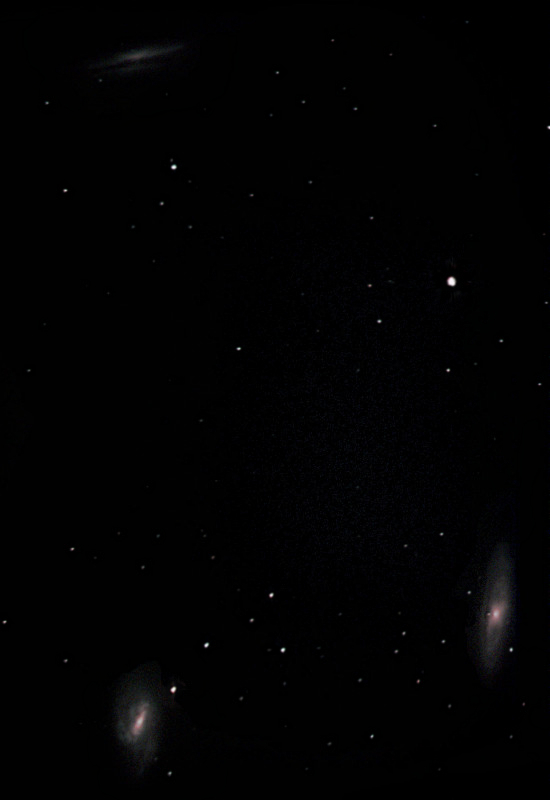
10.1” f/4.5, Mallincam DS432cTEC with Meade Series 4000 Nebular Filter
Exposure = 15 sec, Live Stacked frames = 72, Gain = 80 of 250
M66 is to the lower left, M65 at lower right, and NGC 3628 at top. This EAA view of the Leo triplet shows approximately the kind of detail that would be seen at the eyepiece of a 25″ to 30″ scope! Dark lanes bisecting NGC 3628 (the “Hamburger” galaxy) and M65 are faintly visible; the barred nature of M66 is clearly visible About 20′ separate M65 and M66. All three galaxies appear to be about 8′ in length.
North at 12 o’clock, East at 9 o’clock
M71
M71
Arrowhead cluster in Sagitta
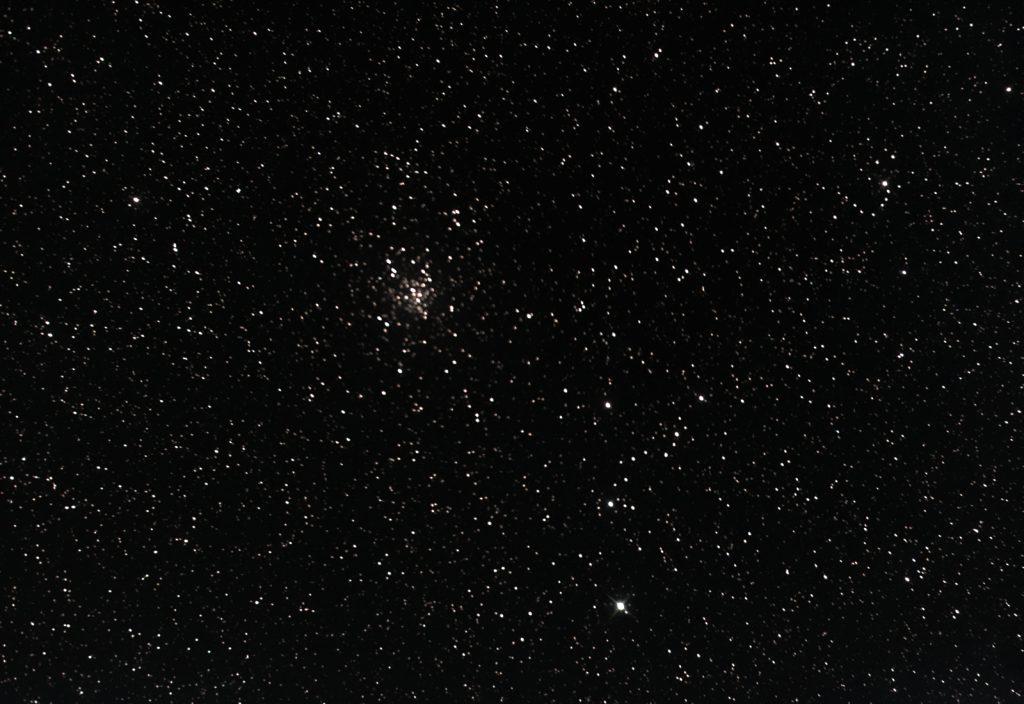
10.1″ f/4.5, Mallincam DS432cTEC with 0.5 focal reducer and Astronomik UHC filter
Exposure = 5 sec, Live Stacked frames = 25, Gain = 70 of 250
M71 is a loosely packed globular cluster with a resolvable core, which makes it look very much like an open cluster at first glance. The shape of the core very much resembles that of an arrowhead pointing in a south-westerly direction – to see what this looks like in the eyepiece, compare against what I have previously sketched. There are a couple of neat chains of stars in the field of view; on the right is a small semi-circle of nine stars punctuated by a brighter star; below and to the right of the globular is a “tennis bracelet” string of about 12 stars punctuated on either end by brighter stars. At bottom the brighter magnitude 6.2 star is 9 Sagittae. M71 is a very close and young globular, 13,000 light years away (which probably explains the resolvability of its core) and about 9 to 10 billion years old. In the sky it appears about 6 arcminutes across and in reality it spans 27 light years.
North at 1 o’clock, East at 10 o’clock
M74
M74
Phantom Galaxy in Pisces

10.1″ f/4.5, Mallincam DS432cTEC
Exposures = 10-15-20-25 sec, Live-stacked frames = 15-15-15-13 (58 total), Gain = 12-11-10-9 of 250
The low surface brightness of this face-on spiral made it very difficult to locate, despite its size; had to increase gain quite a bit to find it against the background stars. Successive exposures though started to reveal the beautiful “grand design” structure of this galaxy. Distance is listed as approximately 32 million light years away. Apparent size of the galaxy in this view is about 6 minutes of arc.
North at 12 o’clock, East at 9 o’clock
M77 (2022-11-26)
M77
Seyfert galaxy in Cetus
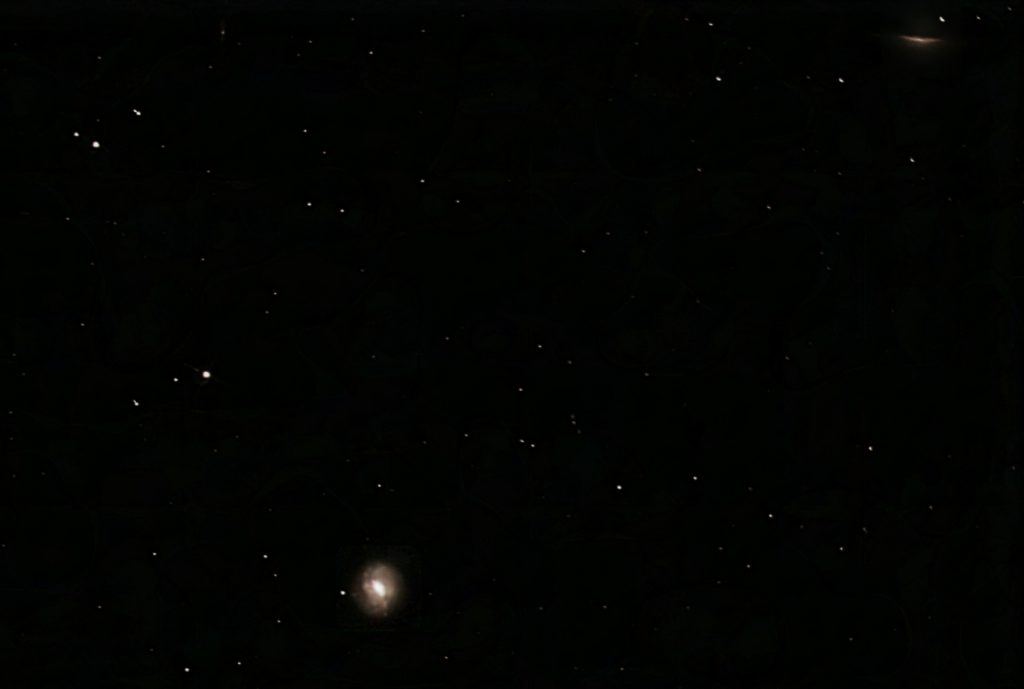
10.1″ f/4.5, Mallincam DS432cTEC with Astronomik UHC filter
Exposure = 10-20-29 sec, Live Stacked frames = 35-20-15 (70 total), Gain = 50 of 250
M77 (bottom) appears here in this view alongside galaxy NGC 1055, at top. M77 is a Seyfert galaxy, the only one of its kind in the Messier catalog; as indicated in Wikipedia, Seyfert’s have “quasar-like nuclei (very luminous, distant and bright sources of electromagnetic radiation) with very high surface brightnesses whose spectra reveal strong, high-ionisation emission lines.” Burnham’s describes “three distinct sets of spiral arms” – a bright inner spiral pattern, seen above as a bright oval core, a second fainter spiral pattern visible here as an open spiral structure with thick knots about 2 arc minutes across, and then a third very faint low surface brightness set of outer arms, not visible here. The star that appears immediately to the left of the galaxy is 10th magnitude. M77 is listed as 47 million light years away.
NGC 1055 (52 million light years away) lies about 30 arc minutes to the north-north west of M77. It is an edge-on spiral that has a distinct pancake shape, slightly inclined with its dark dust lanes on the top-side of the disk.
North at 1 o’clock, East at 10 o’clock
M78 (2023-02-08)
M78
Reflection nebula in Orion
10.1″ f/4.5, Mallincam DS432cTEC
Exposure = 7-13-20 sec, Live Stacked frames = 15-15-45 (75 total), Gain = 6 of 250
One of the few reflection nebula in the Messier catalog, M78 (also known as NGC 2068 and “Casper the Friendly Ghost” nebula) is the brightest portion in the image here, spanning about 7 or 8 arcminutes and 3 light years across. The blue nebula is powered by the two bright blue stars at its center. M78 is about the same distance as the Orion Nebula, 1350 light years away, and also part of the Orion molecular cloud complex.
West (right) of M78 is a faint vertical bar, NGC 2067, and then south of that NGC 2064 is the faint oval puff-ball near the bottom of the image. These, and NGC 2071 which is the nebula near the top of the image (with bright double-star at center) are all connected by partially illuminated and dark dust clouds, some of which you can see cutting across parts of each nebula, creating darker rifts in the background glow. A portion of that background glow is due to light pollution, having stretched the data it is difficult to remove entirely with post-processing without losing some of the details.
North at 1 o’clock, East at 10 o’clock
more images..
M79 (2023-01-14)
M79
Globular cluster in Lepus

10.1″ f/4.5, Mallincam DS432cTEC
Exposure = 8 sec, Live Stacked frames = 55, Gain = 6 of 250
This globular cluster is in an unusual part of the sky directly opposite the galactic center, 42,000 light years away and 118 light years across, both farther and smaller than M13. M79 has a considerably dense core; Burnham’s lists it as “cRi, eC” which is short form notation for “considerably rich, extremely condensed” and it appears to be about 4 arcminutes across in this view, one of the smaller Messier globulars. It’s size and southerly location make it difficult to image from my home location in Eastern Ontario, at the time this was taken it was due south but barely 20 degrees above the horizon.
North at 2 o’clock, East at 11 o’clock
M-80 (2024-05-31)
M80
Globular cluster in Scorpius

10.1″ f/4.5, Mallincam DS432cTEC
Exposure = 5 sec, Live Stacked frames = 20-20 (40 total), Gain = 6-16 of 250
M80 is a bright but very small globular cluster located 4.5 degrees north-west of Antares. It’s core is very bright and unresolvable at this scale (I would like to revisit it with higher power) and the extremities contain bright stars spread more or less equally in a circular pattern with an additional Y-shaped pattern superimposed. It appears about 5 arc minutes across; in actuality it is 96 light years in diameter and 33,000 light years away. M80 is a fairly southern object, at the time this image was taken it was just over 20 degrees above the horizon.
North at 11 o’clock, East at 8 o’clock
M81 and M82
M82 and M81
Cigar Galaxy and Bode’s Galaxy in Ursa Major
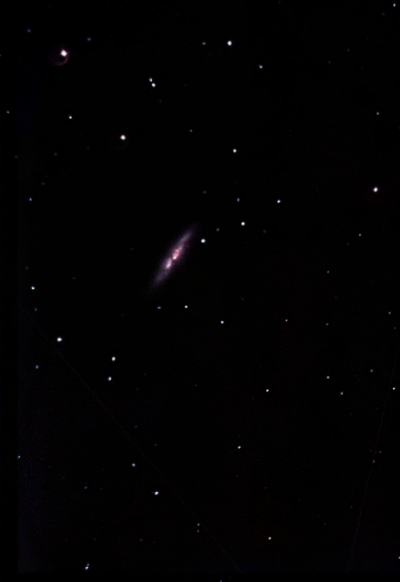
10.1” f/4.5, Mallincam DS432cTEC with Meade Series 4000 Nebular Filter
Exposure = 13 sec, Live Stacked frames = 72, Gain = 23 of 250
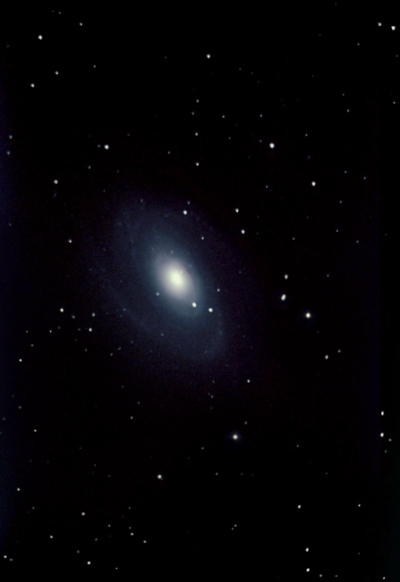
10.1” f/4.5, Mallincam DS432cTEC with Meade Series 4000 Nebular Filter
Exposure = 20 sec, Live Stacked frames = 100, Gain = 50 of 250
M81 (Bode’s) is the large tilted spiral to the right, M82 (Cigar) the edge-on irregular galaxy at left.
They make for an incredible pairing, separated by only 35 arc minutes in the sky. M81 appears about 20 arc minutes across, showing some spiral structure and a very bright central core with two stars superimposed onto the disk. M82 appears as a long thin nebulous bar about 8 arc minutes long and 1.5 arc minutes thick, with rifts and knots plainly visible. The variance in colour along the length of the disk is quite striking.
Both galaxies are about 12 million light years away and are part of the M81 group of galaxies, a neighbour to the Local Group. M81 is about 100,000 light years across, while M82 is about 40,000 light years.
North at 9 o’clock, East at 6 o’clock
M100 (2024-05-06)
M100
Blowdryer Galaxy in Coma Berenices


10.1” f/4.5 Mallincam DS432cTEC
Exposures = 10-20 sec, Live-stacked frames = 50-40 (90 total), Gain = 15 of 250
Also known as the Mirror of M99, M100 is an intermediate spiral galaxy located about 55 million light years away. One of the largest galaxies in the Virgo Super Cluster, M100 is thought to be slightly larger than the Milky Way; in this image, it appears about 5 arc minutes across. There are two main spiral arms gently wrapping themselves loosely around the core, with what appears to be “split-end” fainter hints of arms next to them. Burnham’s describes bright nebulous regions ornamenting the spiral arms like pearls on a string; this effect appears especially in the southern arm. A couple of colours are apparent, a predominantly reddish colour along with blue-grey tinges in spots along the arms and nearer the core, vaguely resembling the colours seen in this image Hubble provides.
There are a number of other smaller galaxies appearing in the field of view, including a couple of satellite galaxies of M100 lying at 9 and 11 o’clock. How many smaller galaxies in total can you find?
M101 (2023-04-14)
M101
Pinwheel Galaxy in Ursa Major

10.1” f/4.5 Mallincam DS432cTEC
Exposures = 5-10-15-15 sec, Live-stacked frames = 30-30-30-20 (110 total), Gain = 25 of 250, Whitepoints = 255-255-255-175
A beautiful face-on spiral, M101 immediately appears very large in the view and it doesn’t take long for the spiral arms to reveal themselves. A number of other NGCs can be seen in this image; NGC 5461 and 5462 are ionized hydrogen regions that appear as brightish smudges of nebula in the lower spiral arm at 5:30 and 7 o’clock respectively. NGC 5471, another HII region, appears as the brightest “star” further down the 7:00 line. Another appearing as a star is NGC 5455 at 3 o’clock in the dim extremities of another spiral arm, and there are more HII regions appearing in the spiral arms above the core. Overall the apparent size of the galaxy is about 20 arc minutes; it’s listed as 170,000 light years across or about twice the size of the Milky Way, with 1 billion suns, and about 21 million light years away.
North is at 9 o’clock, East at 6 o’clock
more images..
M104
M104
Sombrero Galaxy in Virgo
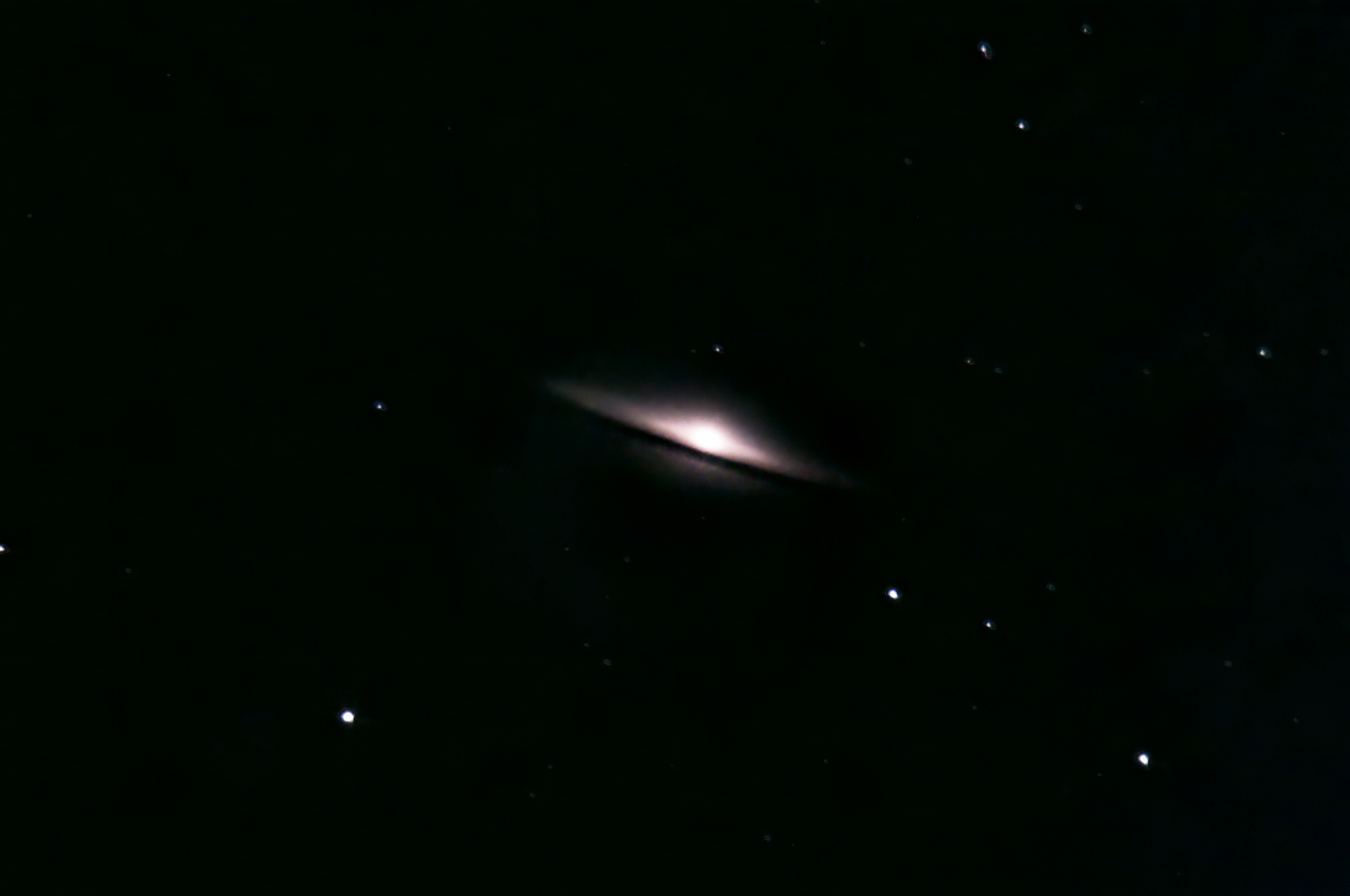
10.1” f/4.5 Mallincam DS432cTEC with 1.5x Barlow
Exposures = 5-10-15 sec, Live-stacked frames = 25-26-49 (100 total), Gain = 22 of 250
The Sombrero Galaxy, seen here with a 1.5x Barlow at about 125x magnification, was easily spotted about 11 degrees due west of 1st magnitude Spica right near the Virgo-Corvus boundary. The dark dust lane on the lower southerly edge of the galaxy began to become apparent after 6 or 7 minutes of exposure time. This nearly edge-on spiral appears to be about 5 arcminutes in length in this image, its actual size is approximately the same as the Milky Way (100,000 light years across). It’s listed as approximately 31 million light years away and is considered part of the Virgo Supercluster of galaxies.
North is at 1 o’clock, East at 10 o’clock
M106
M106
Spiral Galaxy in Canes Venatici

10.1” f/4.5 Mallincam DS432cTEC with Meade Series 4000 Nebular Filter
Exposures = 20 sec, Live-stacked frames = 65, Gain = 50 of 250
Located about halfway between Phecda in the bowl of the Big Dipper and Chara (Beta Canum Venaticorum), M106 is a bright spiral about 24 million light years away. It is listed as an intermediate spiral, i.e. between barred and unbarred classifications. Its two main arms provide a ghostly, wispy looking appearance. According to Wikipedia, M106’s distinctive purple colour is a result of a water vapor megamaser within the galaxy itself. M106 appears to be about 10 x 4 arc minutes in size in this picture, and is quite large at 135,000 light years across and about 24 million light years away.
About 13 arc minutes northeast of M106 is the irregular/pecular dwarf spiral NGC 4248, a small thin fuzzy line about 2 arc minutes long by 1/2 an arc minute thick.
North at 12 o’clock, East at 9 o’clock.
8^)

